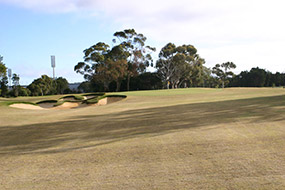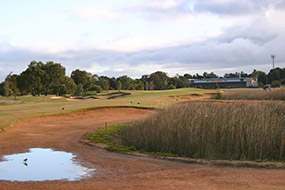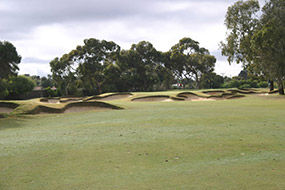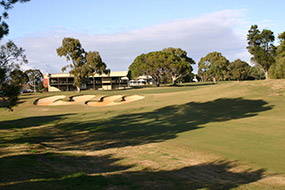The Grange Golf Club is a private members club. Visitors from Interstate or Overseas are welcome during certain periods of the week. Such visitors will need to be members of a recognised golf club, with a current membership identification card or a letter of introduction from the home club. Contact Planet Golf for assistance with tee times.
When Greg Norman decided to close down his Sydney design office he must have known that his next Australian project was going to be heavily scrutinized. For years, under the leadership of chief designer Bob Harrison, Greg Norman Golf Course Design had produced quality work across Australia and throughout Asia. With Harrison and Harley Kruse gone, it would be left to the Shark’s Florida office to handle the Asia Pacific region, and for Australian clients there was a degree of uncertainty about what this meant.
As it turns out, Norman’s first major Australian client in the post-Harrison era was The Grange Golf Club in Adelaide, the scene of his very first professional victory way back in 1976. The West Course at The Grange was originally designed by Vern Morcom in the 1950s, but completely transformed by Michael Clayton’s company prior to the 2008 World Amateur Teams Championship. Clayton had also been commissioned to redesign the East Course, but shortly after starting work the membership had a rethink and decided to establish a clear point of difference between their two courses by engaging a different architect. Once Norman indicated an interest in the project, the decision for the club was simple.
In winning the contract to redesign the East Course at The Grange Norman beat out Harrison and a number of other local architects. He then installed an associate, Ryan VanDerVeen, as his lead designer and construction supervisor and set about reshaping the under-performing layout.
Like the West, East was originally designed by Vern Morcom, although it was built in the 1960s and on ground that was not quite as attractive as the West. There are sandy areas here, but fewer interesting golf undulations and a number of mature trees and cramped golf corridors. For Norman’s team, overcoming the problem spots and injecting some drama into the layout was the priority. Structurally they retained most of Morcom’s routing, with the par five 4th converted into two shorter holes and the old par three 8th and 16th holes replaced with a short peach at the 15th.
The most noticeable feature of Norman’s new East Course is the bunkering, with most of the hazards big, deep and boldly shaped to catch the golfer’s attention. There is certainly an argument to be made that the design team went overboard in places, but where they showed a little restraint the traps are both attractive and strategically effective. Especially good are bunkers built within more expansive playing areas, such as at the par five 16th. These hazards contrast starkly with those on the tighter holes, where sand tends to dominate and dictate how weaker hitters have to play. The short par four 4th, for example, would be a terrific hole for the majority of players were its fairway not pinched unnecessarily by a deep bunker complex located on the opposite side of a fairway that bends gently around a long waste bunker.
The other obvious concern with the East Course are uncomfortably cramped landing areas at the 10th, 11th and 18th fairways. This section of the property also incorporates the par three 12th and is really too tight for four holes, so Norman’s team was somewhat restricted in what could be done here. On balance they did well to stretch things as far as they could, but the fact that the 10th and 11th, in particular, are tight and fall away to the outside of the dogleg is far from ideal. The issue on the 18th has been somewhat addressed by a stack of sand leading to the green, which will force the vast majority of players to lay back safely and play it as a true three-shot hole. Things are also a little tight on front nine holes like the 6th and 7th.
On the positive side, the new par three 12th, despite being squeezed between two narrow holes, is a significant improvement on the previous version and boasts a welcoming green with enough movement to catch those who leak too far from the left hand bunker. The subtle nature of the putting contours here is symptomatic of the work done elsewhere by VanDerVeen and his superiors. Mostly the greens are terrific, and full of both elegance and variety. The aforementioned 4th has a wonderfully intricate target set obliquely to the fairway and complicated by a single hump on its left side and a shallow falloff on the right. Aside from the bold Redan-esque par three 5th green and the steep false front on the par five 7th, the rest of the targets are relatively understated.
For the majority of Grange members there is no doubt that the redevelopment of their East Course will be a viewed a success. The aim of the club to create a point of difference has certainly been achieved and few visitors will leave underwhelmed by the experience.
While Norman and his team were unable to fully overcome some of the routing problems here, on balance they did a good job with this project. It may not be the best course in Australia, but Grange East is much closer to the best course in Adelaide now than one would have imagined a couple of years ago.

 this course also has exceptional:
this course also has exceptional:



